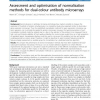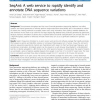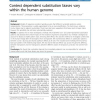BMCBI
2010
13 years 11 months ago
2010
Background: Phylogenies capture the evolutionary ancestry linking extant species. Correlations and similarities among a set of species are mediated by and need to be understood in...
BMCBI
2010
13 years 11 months ago
2010
Background: Microorganisms display vast diversity, and each one has its own set of genes, cell components and metabolic reactions. To assess their huge unexploited metabolic poten...
BMCBI
2010
13 years 11 months ago
2010
Background: Polymerase chain reaction with confronting two-pair primers (PCR-CTPP) method produces allelespecific DNA bands of different lengths by adding four designed primers an...
BMCBI
2010
13 years 11 months ago
2010
Background: Recent advances in antibody microarray technology have made it possible to measure the expression of hundreds of proteins simultaneously in a competitive dual-colour a...
BMCBI
2010
13 years 11 months ago
2010
Background: The enormous throughput and low cost of second-generation sequencing platforms now allow research and clinical geneticists to routinely perform single experiments that...
BMCBI
2010
13 years 11 months ago
2010
BMCBI
2010
13 years 11 months ago
2010
Background: Microarray experiments have become very popular in life science research. However, if such experiments are only considered independently, the possibilities for analysi...
BMCBI
2010
13 years 11 months ago
2010
Background: Our current understanding of transcription factor binding sites (TFBSs) in sequenced prokaryotic genomes is very limited due to the lack of an accurate and efficient c...
BMCBI
2010
13 years 11 months ago
2010
Background: Mass spectrometry (MS) is an essential analytical tool in proteomics. Many existing algorithms for peptide detection are based on isotope template matching and usually...
BMCBI
2010
13 years 11 months ago
2010
Background: Many molecules are flexible and undergo significant shape deformation as part of their function, and yet most existing molecular shape comparison (MSC) methods treat t...



